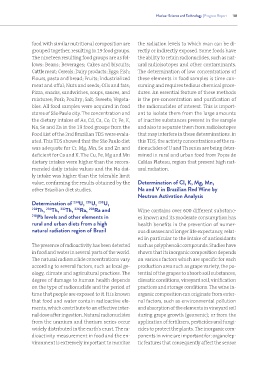Page 181 - 00. Complete Version - Progress Report IPEN 2014-2016
P. 181
Nuclear Science and Technology | Progress Report 181
food with similar nutritional composition are the radiation levels to which man can be di-
grouped together, resulting in 19 food groups. rectly or indirectly exposed. Some foods have
The nineteen resulting food groups are as fol- the ability to retain radionuclides, such as nat-
lows: Beans; Beverages; Cakes and biscuits; ural radioisotopes and other contaminants.
Cattle meat; Cereals; Dairy products; Eggs; Fish; The determination of low concentrations of
Flours, pasta and bread; Fruits; Industrialized these elements in food samples is time con-
meat and offal; Nuts and seeds; Oils and fats; suming and requires tedious chemical proce-
Pizza, snacks, sandwiches, soups, sauces, and dures. An essential feature of these methods
mixtures; Pork; Poultry; Salt; Sweets; Vegeta- is the pre-concentration and purification of
bles. All food samples were acquired in food the radionuclides of interest. This is import-
stores of São Paulo city. The concentration and ant to isolate them from the large amounts
the dietary intakes of As, Cd, Ca, Co, Cr, Fe, K, of inactive substances present in the sample
Na, Se and Zn in the 19 food groups from the and also to separate them from radioisotopes
Food List of the 2nd Brazilian TDS were evalu- that may interfere in these determinations. In
ated. This TDS showed that the São Paulo diet this TDS, the activity concentrations of the ra-
was adequate for Cr, Mg, Mn, Se and Zn and dionuclides of U and Th series are being deter-
deficient for Ca and K. The Cu, Fe, Mg and Mn mined in rural and urban food from Poços de
dietary intakes were higher than the recom- Caldas Plateau, region that present high nat-
mended daily intake values and the Na dai- ural radiation.
ly intake was higher than the tolerable limit
value, confirming the results obtained by the Determination of Cl, K, Mg, Mn,
other Brazilian diet studies. Na and V in Brazilian Red Wine by
Neutron Activation Analysis
Determination of U, U, U,
234
235
238
232
230
226
228 Th, Th, Th, Ra, Ra and Wine contains over 600 different substanc-
228
210 Pb levels and other elements in es known and its moderate consumption has
rural and urban diets from a high health benefits in the prevention of numer-
natural radiation region of Brazil ous diseases and longer life expectancy, relat-
ed in particular to the intake of antioxidants
The presence of radioactivity has been detected such as polyphenolic compounds. Studies have
in food and water in several parts of the world. shown that its inorganic composition depends
The natural radionuclide concentrations vary on various factors which are specific for each
according to several factors, such as local ge- production area such as grape variety, the po-
ology, climate and agricultural practices. The tential of the grapes to absorb soil substances,
degree of damage to human health depends climatic conditions, vineyard soil, vinification
on the type of radionuclide and the period of practices and storage conditions. The wine in-
time that people are exposed to it. It is known organic composition can originate from exter-
that food and water contain radioactive ele- nal factors, such as environmental pollution
ments, which contribute to an effective inter- and absorption of the elements in vineyard soil
nal dose after ingestion. Natural radionuclides during grape growth (geonenic); or from the
from the uranium and thorium series occur application of fertilizers, pesticides and fungi-
widely distributed in the earth’s crust. The ra- cides to protect the plants. The inorganic com-
dioactivity measurement in food and the en- ponents in wine are important for: organolep-
vironment is extremely important to monitor tic features that consequently affect the sensor

